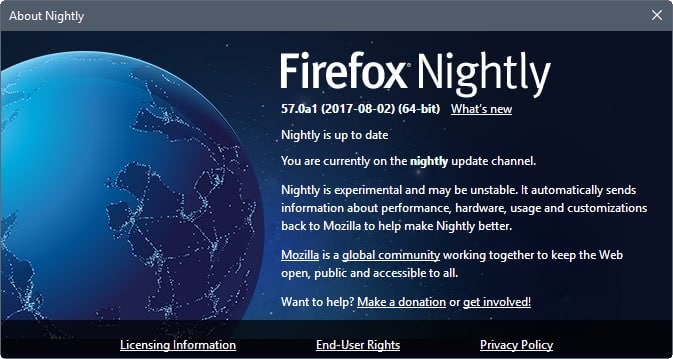

As always, settings exposed only under about:config are considered experimental and subject to change. While ECH is under active development, its availability may be intermittent as it requires both the client and server to support the same version. This can be done in about:config by setting and _https_rr_as_altsvc to true, which will allow Firefox to use ECH with servers that support it. Though we recommend that users wait for ECH to be enabled by default, some may want to enable this functionality earlier. Users that have previously enabled ESNI in Firefox may notice that the about:config option for ESNI is no longer present.
#FIREFOX ESR VS FIREFOX UPDATE#
Firefox 85 replaces ESNI with ECH draft-08, and another update to draft-09 (which is targeted for wider interoperability testing and deployment) is forthcoming. In keeping with our mission of protecting your privacy online, Mozilla is actively working with Cloudflare and others on standardizing the Encrypted Client Hello specification at the IETF. Where ESNI may currently fail after receiving stale keys from DNS, ECH can securely recover, as the client receives updated keys directly from the server. Importantly, ECH also adds a retry mechanism to increase reliability with respect to server key rotation and DNS caching. Key derivation and encryption are made more robust, as ECH employs the Hybrid Public Key Encryption specification rather than defining its own scheme. This is explained in more detail in Cloudflare’s excellent blog post on ECH.ĮCH also changes the key distribution and encryption stories: A TLS server supporting ECH now advertises its public key via an HTTPSSVC DNS record, whereas ESNI used TXT records for this purpose. Should a server support ECH and successfully decrypt, the “Inner” Client Hello is then used as the basis for the TLS connection. Any extensions with privacy implications can now be relegated to an encrypted “ClientHelloInner”, which is itself advertised as an extension to an unencrypted “ClientHelloOuter”. To address the shortcomings of ESNI, recent versions of the specification no longer encrypt only the SNI extension and instead encrypt an entire Client Hello message (thus the name change from “ESNI” to “ECH”). Lastly, real-world use of ESNI has exposed interoperability and deployment challenges that prevented it from being enabled at a wider scale. The ESNI approach would require an encrypted variant of every extension with potential privacy implications, and even that exposes the set of extensions advertised.


As just one example: during session resumption, the Pre-Shared Key extension could, legally, contain a cleartext copy of exactly the same server name that is encrypted by ESNI. Since publication of the ESNI draft specification at the IETF, analysis has shown that encrypting only the SNI extension provides incomplete protection.

This represents a privacy leak similar to that of DNS, and just as DNS-over-HTTPS prevents DNS queries from exposing the hostname to on-path observers, ESNI attempts to prevent hostname leaks from the TLS handshake itself. The Server Name Indication (SNI) TLS extension enables server and certificate selection by transmitting a cleartext copy of the server hostname in the TLS Client Hello message. Two years ago, we announced experimental support for the privacy-protecting Encrypted Server Name Indication (ESNI) extension in Firefox Nightly.


 0 kommentar(er)
0 kommentar(er)
